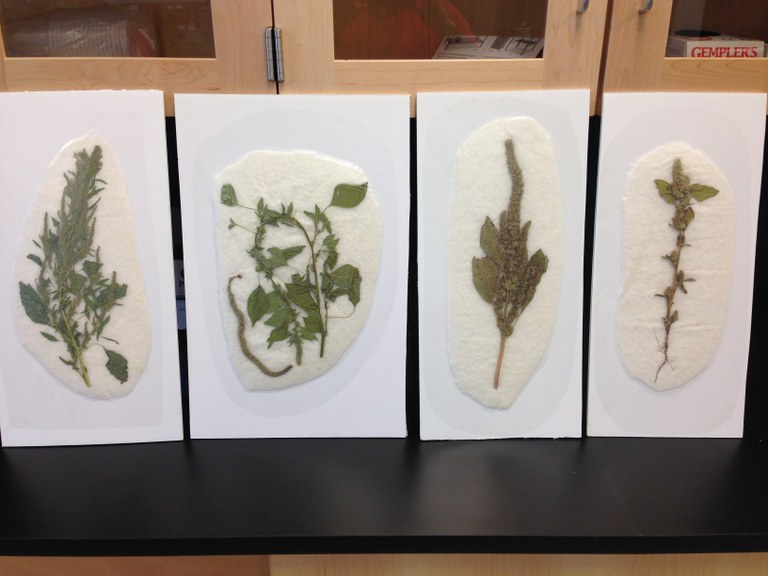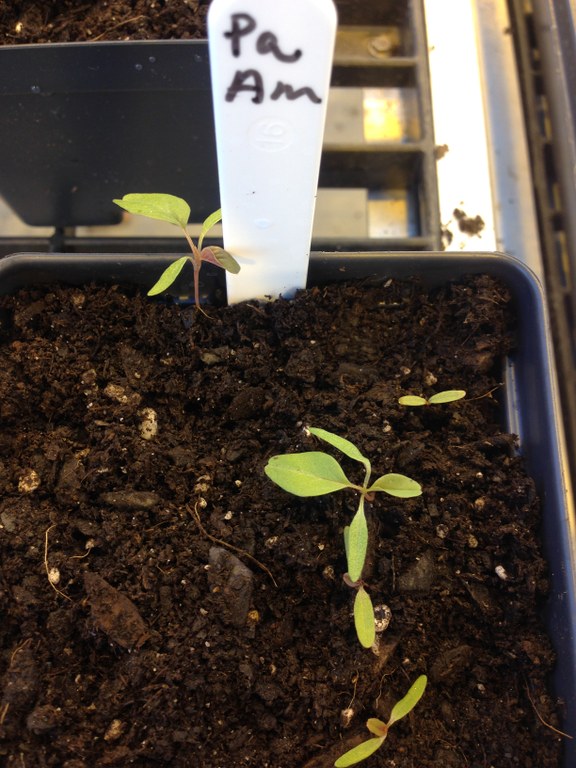Palmer Amaranth Identification and Biology
Palmer amaranth (paam) arrived in North Dakota in 2018 (five counties) and poses a major threat to our agricultural land in 2019 and beyond. Paam has recently been declared a ND State Noxious Weed. By law and for crop production, the weed must be controlled. It is highly recommended to have zero tolerance for paam = eradication.
The first step in weed management is plant identification. Some basics for identifying paam plants include no hairs on stems or leaf petioles, petiole length similar to and generally longer than leaf length, female plants have spiny bracts (paam is dioecious = a plant has either female or male flower parts, not both), and one primary seed head present ranging from 1- to 4-feet in length. Pigweed species in the coytyledon through at least 2-true leaf stage are very difficult to distinguish. However, by the 4- to 6-leaf stage, if hairs are observed on the upper part of a plant, the pigweed is not paam or waterhemp (likely redroot pigweed or Powell amaranth). If the pigweed plant does not have hairs and at about 4-inch height or taller, leaf petioles (oldest leaves) should be longer than leaf length, indicating paam versus waterhemp. Also, waterhemp leaves typically are narrow, twice as long as wide, and normally are shiny in appearance. Additional paam identification tips can be found at the following website: www.ag.ndsu.edu/palmeramaranth. Also, the Carrington Research Extension Center has live seedlings and mature dried plant displays of paam, which are available for examination.
 Pigweed plant mounts, paam second to left.
Pigweed plant mounts, paam second to left.
Some notes on paam biology (main source: Joe Ikley, NDSU Extension weed specialist) to help describe characteristics of this formidable enemy:
- Native to southwest desert area of U.S. Thus, can readily tolerate drouth and high temperatures (>100 degrees F).
- Seed can germinate throughout the growing season (last half of May through September) triggered by single rainfall events. Plants 2-inches or 10-feet tall can produce seed. A large (female) plant can produce 1 million seeds. Seed is viable about one week after flower pollination. Only one month is necessary from seed germination to new seed production. Seed is viable in the soil for about 3- to 5-years.
- Paam (and waterhemp) have a more rapid growth rate than other pigweed species. Rapid growth begins at 2- to 4-inch height, and with optimum growing conditions, 1- to 3-inch length can occur per day. Plant height of 4 inches is the maximum for control with post herbicides, which occurs about one month after soybean planting (assuming weed-free conditions at planting).

Paam seedling.
During the 2019 growing season, if paam is found in new areas, likely this will occur late in the season when ‘unusual’ pigweeds are observed above the crop canopy (e.g. soybean) or at field entrances or edges. Scout for paam throughout the crop season. If plants are suspected to be paam, pull and bag plants, remove from field for identification (e.g. NDSU Extension, ND Dept. of Ag, or county weed boards), and then destroy (burn or bury). Guidelines from the ND Dept. of Ag are pending on procedures for eradicating paam from agricultural land.
Greg Endres
Gregory.Endres@ndsu.edu
Extension Agronomist


